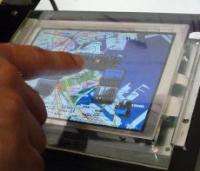Image copyright: Tech-On!, Nikkei Business Publications
(PhysOrg.com) -- A prototyped capacitive touch panel was demonstrated by Mitsubishi Electric Corp at the Interaction 2009 in Tokyo, Japan. The 3D touch panel can detect not only x- and y- coordinates but also its z- coordinates by detecting the distance between a finger and panel. Screen size is approximately 5.7 inches with a resolution of 640 x 480 pixels.
The 3D touch panel functions by switching between two detection methods and would be determined by the position of the finger. When a finger approaches the panel, it's defined as being in "proximity state" After the finger is in contact with the panel it's in "contact state". In "proximity state", priority is given to the screen's sensitivity and in "contact state", resolution has priority.
The panel can detect a capacitance change of approximately 0.3pF in the proximity state and about 8 to 19pF in the contact state, according to a spokesperson for Mitsubishi Electric Corp.
In the proximity state the resolution in the x- and y- axis is equivalent to 10mm. In respect to the z-axis direction, "it is possible to determine the distance of the finger as long as it is less than 20mm," the spokesperson said. The company also stated that in the contact state, the resolution in the x-axis and y-axis directions is equivalent to 0.2mm.
Sensitivity in the proximity state is increased by connecting multiple sensors to increase the sensor area. Parasitic capacity has also been reduced by adding a "sensor shield control". This function eliminates the need for a shield layer that reduces electromagnetic noise generated from an LCD panel.
This prototype is based on a capacitive touch panel that is available on the market today, and only required a few changes. The changes involved adding switch elements to connect multiple sensors and improved the detection circuit to reduce its parasitic capacity.
Since the touch panel is still in its developmental stages, there is no set time as to when it will be publically announced. The company needs to verify its resistance to environment as well as operability in actual devices before it can become marketable.
via Tech-On!, Nikkei
© 2009 PhysOrg.com






















